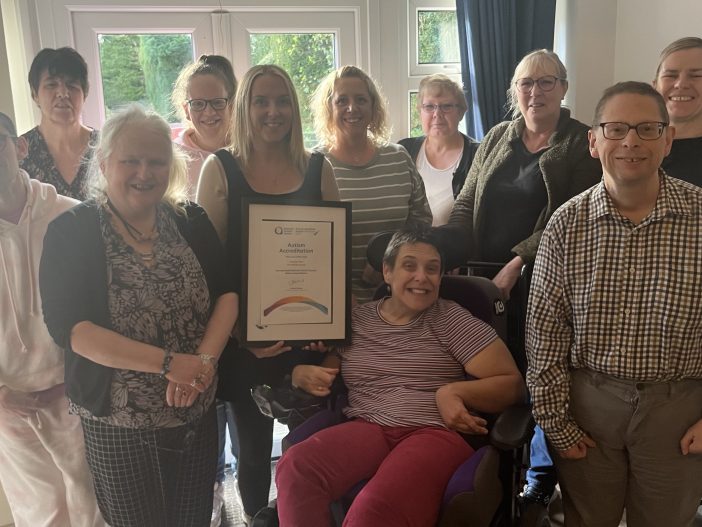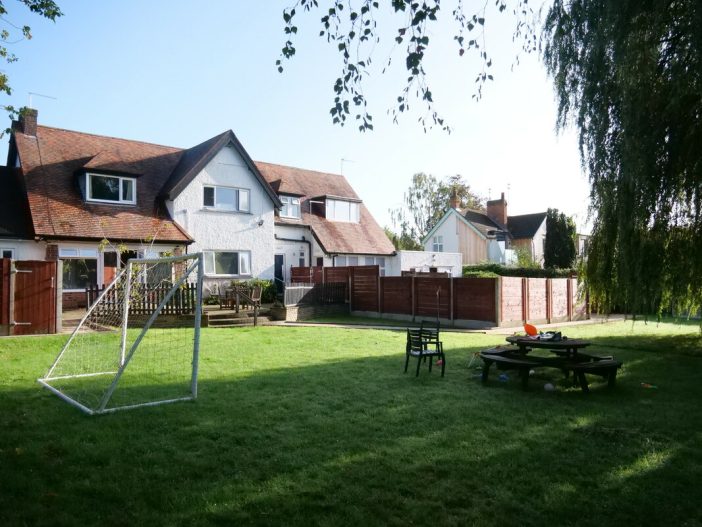Voyage Care Podcast S1E3: Kelly and Dave – Specialist behavioural support and person-centred care
Welcome to the brand-new Voyage Care podcast! In this season, we’ll be focusing on how our services deliver person-centred care to the people we support.
For episode three, we’re hearing from Kelly, our SBSS Business Development manager and Dave, Head of Behavioural Support. They’ll be explaining what Specialist Behavioural Support Services is, and how important it is to provide individuals within those services with person-centred care. They’ll also be sharing some of their favourite stories, and some important lessons learnt.
Specialist behavioural support and transforming care
Visit our specialist behavioural support webpage to read more about how we provide bespoke support for people stepping down from hospital stays to our services.
Can’t listen right now?
Read the transcript of the podcast below.
Kelly:
So welcome to our podcast on person-centred care, which we wanted to record in the context of the Winterbourne View 10-year anniversary. 2021 is 10 years on from the shocking Panorama investigation, which led to transforming care and building the right supports, which aim to half the number of people with a learning disability and autistic people in inpatient settings by 2019. Dave and I support the development of services within our specialist behaviour support services specialism, and this is also known as SBSS. So, my role is business development manager. My name is Kelly Thompson, and I specifically support the development of services under SBSS. And I’m joined by Dave.
Dave:
Hello everybody my name is Dave Barlow, Head of Behavioural Support services and I manage a team of 10 behaviour support practitioners whose role is to support Kelly and the transfer of people from inpatient settings into our community and residential services under SBSS. I’ve worked with Kelly to develop the SBSS framework and today we’re going to answer some of our considerations when we were setting out.
Kelly:
So SBSS includes putting people who are both preparing for discharge from hospital or people who may be at risk of being admitted to hospital, perhaps due to placement breakdown or an increase in high-risk behaviours. And for us, the key part of SBSS is ensuring that people can live a really good and fulfilled life in the community. And for us that means ensuring that our support puts the person at the centre. So we wanted to start the podcast by focusing on person-centred transitions. And I guess Dave the key question for me is what is key from our experience in terms of ensuring that there’s a person-centred approach to transitional planning, with someone who’s actually preparing for discharge from hospital who may have been in hospital for many years, the kind of key thing that comes to my mind straight away is from our experience is certainly making sure there’s a partnership approach.
Dave:
Absolutely, the most important person in the whole process is the individuals themselves. And one of the things we found really, really important is they are involved, and we use whatever method of communication we can for that individual to show where we are in that discharge process. Really important they can, to the best of their capabilities understand. An important consideration for that individual, particularly if they’ve been resident in hospital for a long time, is life can be pretty scary outside of the hospital. And so, it’s really important they are involved. Equally family members, we found it’s really important to be clear and honest about progress and also providing reassurances of where we are in that progress. Particularly a reassurance that we are an acceptance we’re looking after somebody’s son or daughter and families may be naturally anxious if there’ve been previous failed placements.
Dave:
So again, it’s important we support the family to know the journey. The third group we’ve learned is the hospital team themselves. They’ve been a few occasions where assumptions have simply been made that at the point of discharge all is good as it were. And what we’ve found sometimes is that needs to be very sensitively, but clearly managed particularly when we need to recruit and train a staff team, because we want to focus on that individual and give them the best opportunity to make that discharge and transition a success.
Dave:
The fourth group we’ve considered is probably the specialist community teams. We want to work alongside a community, learning disability, mental health, and other teams supporting the individual to make sure that the transition from the hospital to the community is smooth, but in recognition that that’s simply the first step. What we want to make sure is when that person moves to their community setting, they’ve got a nice wrap round group of professionals who on discharge are agreeing an action plan, and that we are also able therefore to make sure should it not work as well as we hoped. We’ve got some actions that people can be responsible to, to take.
Kelly:
Absolutely and I think we’ve worked really well in terms of thinking about how we’re learning from each transition, how we can make that better. So, for example, we’re developing more and more tools around working in a person-centred way so people can actually shape their environment. So that is included tools that we’ve developed, for example, to think about the design and feel of the property where we can actually take those tools into the hospital setting, using things like videos of the environment and things. If people aren’t quite at a stage where they can visit the property, because the property might be under development. That’s give them a feel for the environment from a very early stage so that they can get used to that environment and also make key choices around things like the colours of the walls and things like that. But I think a lot of us perhaps take for granted, but someone’s been involved in that. That might be quite a new thing as well, and as well might be quite overwhelming. So, we need to work with the team and professionals that know them well, to make sure that that’s done in a staged approach, that’s really positive for them,
Dave:
Perhaps not last, but again, an important consideration is some of the people we support may have been detect detained under sections of the mental health act and may be discharged on the same. So, there’s an obligation on ourselves to make sure that we work within that legal framework, that people understand their roles within their framework and also the care team, the care staff know what they need to be supporting within that legal framework and that we meet those dates for review. And then ultimately we support the individual off those sections. As we start the journey, it’s about being realistic with timescales. It’s important to acknowledge, it’s not simply a matter of discharging someone from hospital because they’ve reached the end of the treatment regime, or other. We would advocate the plan should be set for discharge almost at the point of admission, which is very difficult. We accept, but actually there’s a lot of behind the scenes work that needs to be done.
Dave:
I’m particularly advocating this person-centred role with all that in mind, we would like to share just an experience supporting a gentleman in Leicestershire, who moved into one of our projects and right at the very beginning, he would be what was perhaps not very nicely regarded as a revolving door patient. And what that simply meant was he’d been discharged a number of times from this secure setting and placements had broken down and had broken down quite quickly. So, Kelly and I met the young man and also his supporting team in the hospital who were really keen to get it right. One of the very, very important and early considerations was meeting this young gentleman’s father, and it was clear this time it should be right. He himself had conservation personal upheaval.
Dave:
And we just learnt so much about this guy that even the stuff team didn’t know as well. And those sources as we referred to came from family members, for example, we needed to amend some property feature because the brother shared what it had been like to live at home with his younger brother in this example. And so we made the amendment before we moved. We also worked very, very closely with the community autism team to make sure that we got the features of the property right to support this young man. And part of that was making very clear signposted staging of transitional visits. And if I may, this was probably one of the most successful transitions we did. And it culminated in Christmas last year when we were told by the brother in the journey, how they’d never been able to have a Christmas tree up at home. One suspects because of the change in the autistic preachers regarding change.
Dave:
And when he moved out, we put a Christmas tree up to see what would happen. And somewhere is a fabulous picture of this young man and his Christmas tree beaming from ear to ear, which we sent to his dad. And his dad had said he had never seen him smile, but he’d never seen him at Christmas, so happy. So, I think it was the value of making sure that everything we did in this transition maintained our focus on getting it right for this young man. And I’m extremely pleased to say he has become extremely well-settled. The autism and community team have pulled out. They still dip in occasionally, but they’ve pulled out and it’s all down to voyage. But I think that’s a measure of how important getting the detail right in the discharge to give this young man, the life that he now clearly enjoys. But because of that, there was some learnings.
Kelly:
I think the key learning for me was making sure that we had really well-planned transitional supports within the hospital setting before the gentlemen actually moved. And that was really collaborative as well. So, it wasn’t just a case of our team going into the hospital and observing, they were really engaging very closely with the BAT team that knew the gentleman well and receiving regular feedback as well in terms of how they were engaging in communicating with him. So, it was a constant learning and we were debriefing following those sessions as well, to make sure that that learning was shared throughout the team. I think as well from a person-centred points of view. One thing that we really picked up on was the fact that this gentleman takes time to get to know people. And so, it wasn’t a rush transition, we have the time to introduce the team.
Kelly:
And also when he moved, I felt that that team around him, he was very, very familiar with. They’d got to know him, he got to know them and as well, we’ve supported that team to make sure that they’ve got the resilience so that we’ve been able to maintain that consistency. So, we’re not continuously changing the people that are working with him. We’ve made sure that he’s got a core team in place that have got that learning and knowledge around him, so that it’s really consistent and familiar to him. I think for me, looking back at the kind of feedback we got in terms of placements that perhaps have failed in the past, that was kind of a key learning point that we made sure that we got right this time. Linked to that was also some joint training that was delivered collaboratively with the professionals that knew the gentleman well, and that wasn’t just sort of skills development training is very person-centred.
Kelly:
So it was around who that is and how to sort of work with him really well. And the kind of nuances around that, that you wouldn’t necessarily pick up from a generic training course. It was very much specific to him. And obviously the insight from family really shaped that training as well. But it was about recognizing that the gentleman had progressed really well within the hospital setting and it was important for us to move forward. Then when he moved on to a community setting and supportive living and recognize that we didn’t want to just stop there, it was about making sure that he could build a really good life and develop on those skills that he’d started developing within the hospital setting, around key areas such as preparing his own food and accessing activities that he’d started to enjoy within the hospital. They were really proactive in terms of making sure that he could access activities within the community where he was moving to. So, he was already familiar with the kind of community opportunities that we could build on when he actually moved on to supported living, which I think really helped as well.
Dave:
Have there been some key learnings from previous transitions?
Kelly:
Yes. So, I think for me, the key learning was that although we work in a person-centred way, sometimes I think there’s a danger of perhaps making assumptions. And I kind of reflected on this recently when we were developing a property for a lady who was moving on from hospital, she has a trauma history and we wanted to make sure that within her environment she could feel as safe as possible. So, an example of this was we were looking at safety film on her windows, which we felt would be a feature that maybe would provide her with assurance. But when we start to actually engage with the lady, what we found is, although there were features of the property that were really important to her at the same time, what really came across is that she didn’t want her property to stand out as being different.
Kelly:
So, it wasn’t just about getting the key features of that environment right. But it was making sure that the design was really carefully thought about. So that it didn’t feel like a clinical setting. You know, it felt like her own home, it felt like a tenancy and that she could settle there without feeling like that property was any different to her neighbours. And that was what was really important to her. So, I kind of took that away as we can’t forget that while we’ve got to make sure the environment safe and robust and compliments the support. We also need to make sure that we’re thinking about the person and what’s going to work well for them and help them settle within the community setting and their own tendency.
Dave:
So finally, then there was a couple of things, Kelly and I have learned working with teams. And first of all, it’s an acknowledgement that each team within this multidisciplinary team may have different drivers to achieve discharge or new placement. And it’s really important we seek to understand what those drivers are. It’s also important to be honest, right from the start raise concerns and work together to seek a solution, but also to go back and ask for clarity, if it’s needed. Third thing maybe was to be curious and ask the question, why has it failed before? What don’t we want to do is repeat the same thing, ask the question around what if it goes wrong? Clearly you never set up a piece of work with a sort of provision that it’s going to fail. But what we’ve learnt is occasionally the people we support do find it very distressing to move, and inevitably it will go wrong at five to five on a Friday.
Dave:
And what do we do at that point? And so, we came up with the idea of a contingency plan of which we got all the partners within this multi-agency approach to agree their role in that. What do we do if something were to go wrong? I think from my perspective, managing the team, it’s really important that they are involved. The team are possibly over 200 years’ worth of experience and everything they do is central and based around person-centred support, quality of life measures and people getting a good quality can be subjective, but it’s critical that we get it as right as we can, as quickly as we can to embed that new care and provision. That it has such a big impact on the individuals and the success that it’s clear that it’s important that everybody takes their roles responsibly and that when we get it right, perhaps nobody remembers, but when we get it wrong, it seems nobody forgets. So, it’s really important. We get those stages of this journey right and of course the person is at the centre of everything we do.
Kelly:
We wanted to thank you and also just kind of highlight that there’s a lot more information around what we’re delivering, relating to SBSS available on our website. If you could take some time to have a look on there, we hope you’ve enjoyed it.
Dave:
Thank you for listening.
Visit our specialist behavioural support webpage to read more about how we provide bespoke support for people stepping down from hospital stays to our services.
Stay tuned for another episode of our podcast next week.

 Views
Views 

